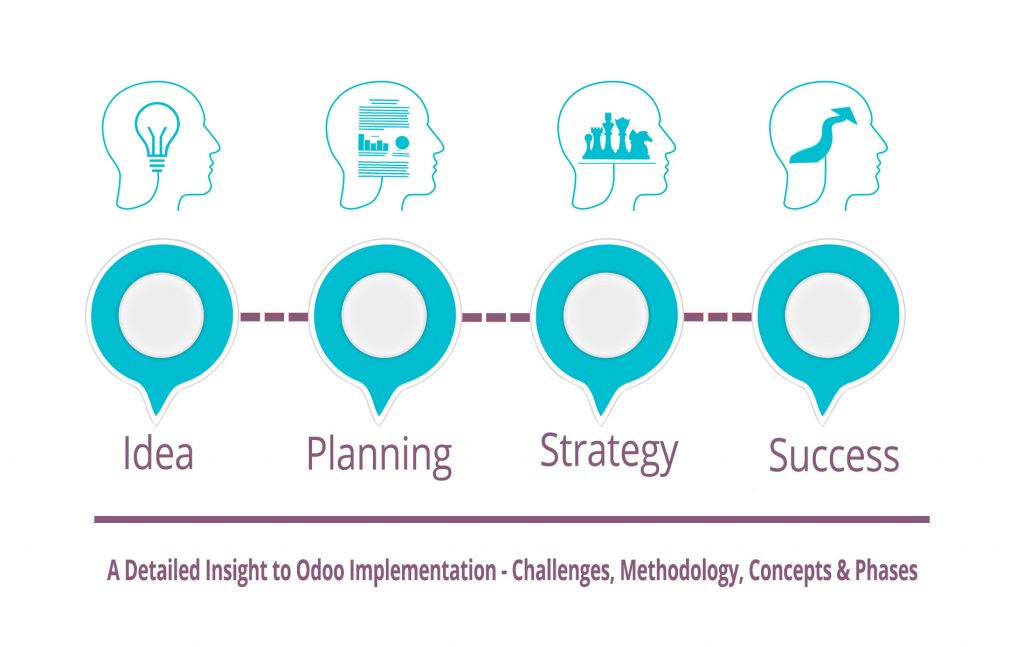Implementation of an Enterprise Resource Planning (ERP) system is one of the most crucial steps that define the success of a business. An appropriate, well-aligned, and functioning implementation of an ERP system streamlines the entire workflow of an organization in a highly efficient manner. Moreover, it helps curb the potential risks while maximizing successful outcomes. Odoo is one of the most versatile ERP systems that tend to incorporate all organizational dynamics to ensure guaranteed services. The article extensively discusses the challenges and methodology of Odoo Implementation to help organizations automate the workflow.
Challenges in ERP Implementation
Order confirmation, development, and affordable solutions are the main concerns of any business. The success of an organization highly depends on these factors that ultimately demand a full-fledged system that serves customers according to their interests.
Identification of customer needs, requirements, and expectations are very important. For this, organizations must prioritize the features and capabilities they want in their system. The process can be easy if you know your audience and their concerns. Some other challenges include;
- Making deals with the people that seem resistant. This requires presenting them with highly customized solutions that align well with their needs.
- Encouraging users to embrace Odoo to automate their entire workflows by making processes simple and efficient.
- Managing customer expectations and ensuring enhanced services.
- Understand the specifications of goods and orders of customers effectively.
- Dealing with the customers by providing them enhanced customer support and real-time updates regarding the order development and shipment.
Once the parameters are defined, Odoo implementation is no more a cumbersome process. Below discussed are the methodology details, concepts, and the phases that are involved in Odoo Implementation and how they can be employed to tailor your Odoo ERP system accordingly.
Read: A Definitive Guide: Business Process Analysis (BPA) and its Implementation
Methodology and Key Concepts
The methodology of Odoo implementation consists of some key concepts that tend to help businesses identify the key goals and shape the ERP system efficiently. Odoo ERP system mitigates the pitfalls that include custom developments, risks of delays that occur due to inefficient order management, and the complexities that make delivery quite complex. Below are some key concepts involved in Odoo implementation;
Process Prioritization
The very first concept is the process of prioritization in which the requirements and needs must be prioritized to customize the ERP software accordingly. The requirements and specifications must be defined and then assigned priority in order to sort them and establish an ERP system that better address the needs of a business.
Streamlined Requirements
All the requirements enlisted in a unified place help business entities make things simpler. For instance, businesses can ensure streamlined business workflow. It is the responsibility of project managers to configure the ERP system. Well-defined requirements make the process of Odoo implementation very easy.
Responsibility
It is the responsibility of service providers to satisfy the customers. Any discrepancy can lead to an increased customer churn rate. From project design decisions to implementation and development, it is your responsibility to ensure optimized customer experiment and satisfy the clientele base to increase the rate of customer retention.
Effective Decision Making
One of the most important concepts in Odoo’s implementation is effective decision making. It corresponds to mapping the right module to ensure the implementation of appropriate requirements. In this, project managers play a critical role. It is a specification of an ERP system to address the customer needs in software.
Also Read: 5 Ways of Harnessing the Benefits of AI and ERP
Phases of Odoo Implementation
There are some phases involved in Odoo implementation. These phases describe the significance of each step and its effectiveness in designing a full-fledge tailored infrastructure of an ERP system. This helps keep a track of each system module efficiently and deliver the desired results efficiently.
ROI Analysis
“Return on Investment” is a crucial element that helps determine the success of an organization in a certain time period. It helps you identify how much an organization is benefiting through which services.
Kick-Off
The second phase is Kick-off which streamlines the process of customer onboarding and helps customers align their vision. Moreover, it helps establish a quick RIO infrastructure, finalize the plan, and acquire potential customers.
Implementation
Incorporating the level of complexity, Odoo implementation must adjust all the features and specifications defined by the client in order to make it useful for the customer. One important tip is to establish an entire framework and pay keen attention in order to boost up each phase and execute it properly.
Go-Live
This is a crucial step in which the software development industry is also called the release of a product or service. An ERP system when goes live could experience some issues with respect to operational structure for the connectivity with the database. Although, this is one phase that holds critical importance in Odoo ERP implementation.
Second deployment
After one release, a project manager might ask for additional implementations or integrations or may ask for improvement of existing modules. For this, a second deployment is done that incorporates the reviews and comments of project managers.
Also Read: Difference between CRM and ERP – A Detailed Insight
Steps Involved in Odoo Agile Development
The following are some steps involved in Odoo implementation by employing the Agile development approach:
1. Pre-Analysis
In the agile approach towards Odoo implementation, the very first step is pre-analysis of the entire requirements document. Access the needs of customers and analyze them in such a way that feasibility of specifications could be determined considering it in the light of the doability and effectiveness.
2. Detailed Analysis
This step in agile development helps developers identify the specifications and advanced features, their input, and investments that would be required in order to make the entire process done effectively.
3. Project Planning
This step, there involves the entire project planning that plays a critical role. Project planning incorporates all the steps that are involved in designing the complete project and helps businesses streamline the entire business workflow.
4. Initiation of Development
In this phase, development starts, and the following modules are reviewed for implementation purposes:
- Dashboard designs
- Workflow implementation
- Report Designs
- Quality Assurance Tests
- Access Rights Management
- Client Walkthroughs
- Deployment
- Client Approvals
- System Integration
- Client Suggestion Implementations
5. Odoo Implementation
In this step, implementation is done for all modules to be present in the system.
6. Data Migration
Data migration is a crucial step in which application installation should be ensured along with configurations and implementation of the processes in a highly effective manner.
7. Training
In-house training is crucial to ensure the automation and processing of tasks without any hindrance. In this step, it is crucial to train the employees and accelerate the module of customer support.
8. Support and Maintenance
Complete maintenance and support should be available to the customers for which modules should have optimized customer service and user experience to make the journey smooth for clients.


